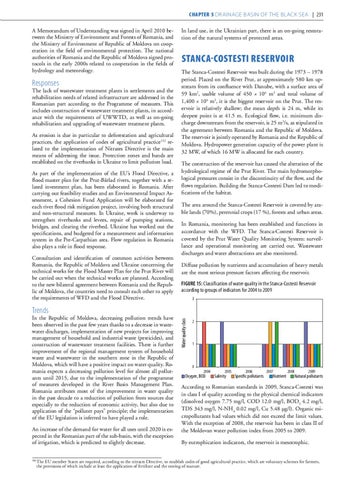Chapter 5 Drainage basin of the Black Sea | 231 A Memorandum of Understanding was signed in April 2010 between the Ministry of Environment and Forests of Romania, and the Ministry of Environment of Republic of Moldova on cooperation in the field of environmental protection. The national authorities of Romania and the Republic of Moldova signed protocols in the early 2000s related to cooperation in the fields of hydrology and meteorology.
Responses
The lack of wastewater treatment plants in settlements and the rehabilitation needs of related infrastructure are addressed in the Romanian part according to the Programme of measures. This includes construction of wastewater treatment plants, in accordance with the requirements of UWWTD, as well as on-going rehabilitation and upgrading of wastewater treatment plants. As erosion is due in particular to deforestation and agricultural practices, the application of codes of agricultural practice132 related to the implementation of Nitrates Directive is the main means of addressing the issue. Protection zones and bands are established on the riverbanks in Ukraine to limit pollution load. As part of the implementation of the EU’s Flood Directive, a flood master plan for the Prut-Bârlad rivers, together with a related investment plan, has been elaborated in Romania. After carrying out feasibility studies and an Environmental Impact Assessment, a Cohesion Fund Application will be elaborated for each river flood risk mitigation project, involving both structural and non-structural measures. In Ukraine, work is underway to strengthen riverbanks and levees, repair of pumping stations, bridges, and clearing the riverbed. Ukraine has worked out the specifications, and budgeted for a measurement and information system in the Pre-Carpathian area. Flow regulation in Romania also plays a role in flood response. Consultation and identification of common activities between Romania, the Republic of Moldova and Ukraine concerning the technical works for the Flood Master Plan for the Prut River will be carried out when the technical works are planned. According to the new bilateral agreement between Romania and the Republic of Moldova, the countries need to consult each other to apply the requirements of WFD and the Flood Directive.
In land use, in the Ukrainian part, there is an on-going restoration of the natural systems of protected areas.
Stanca-Costesti Reservoir The Stanca-Costesti Reservoir was built during the 1973 – 1978 period. Placed on the River Prut, at approximately 580 km upstream from its confluence with Danube, with a surface area of 59 km2, usable volume of 450 × 106 m3 and total volume of 1,400 × 106 m3, it is the biggest reservoir on the Prut. The reservoir is relatively shallow; the mean depth is 24 m, while its deepest point is at 41.5 m. Ecological flow, i.e. minimum discharge downstream from the reservoir, is 25 m3/s, as stipulated in the agreement between Romania and the Republic of Moldova. The reservoir is jointly operated by Romania and the Republic of Moldova. Hydropower generation capacity of the power plant is 32 MW, of which 16 MW is allocated for each country. The construction of the reservoir has caused the alteration of the hydrological regime of the Prut River. The main hydromorphological pressures consist in the discontinuity of the flow, and the flows regulation. Building the Stanca-Costesti Dam led to modifications of the habitat. The area around the Stanca-Costesti Reservoir is covered by arable lands (70%), perennial crops (17 %), forests and urban areas. In Romania, monitoring has been established and functions in accordance with the WFD. The Stanca-Costesti Reservoir is covered by the Prut Water Quality Monitoring System: surveillance and operational monitoring are carried out. Wastewater discharges and water abstractions are also monitored. Diffuse pollution by nutrients and accumulation of heavy metals are the most serious pressure factors affecting the reservoir. FIGURE 15: Classification of water quality in the Stanca-Costesti Reservoir according to groups of indicators for 2004 to 2009 3
Trends
In the Republic of Moldova, decreasing pollution trends have been observed in the past few years thanks to a decrease in wastewater discharges, implementation of new projects for improving management of household and industrial waste (pesticides), and construction of wastewater treatment facilities. There is further improvement of the regional management system of household waste and wastewater in the southern zone in the Republic of Moldova, which will have a positive impact on water quality. Romania expects a decreasing pollution level for almost all pollutants until 2015, due to the implementation of the programme of measures developed in the River Basin Management Plan. Romania attributes most of the improvement in water quality in the past decade to a reduction of pollution from sources due especially to the reduction of economic activity, but also due to application of the “polluter pays” principle; the implementation of the EU legislation is inferred to have played a role. An increase of the demand for water for all uses until 2020 is expected in the Romanian part of the sub-basin, with the exception of irrigation, which is predicted to slightly decrease.
2
1
0
2004
Oxygen, BOD
2005
Salinity
2006
Specific pollutants
2007
Nutrient
2008
2009
Natural pollutants
According to Romanian standards in 2009, Stanca-Costesti was in class I of quality according to the physical chemical indicators (dissolved oxygen 7.75 mg/l, COD 12.0 mg/l, BOD5 4.2 mg/l, TDS 343 mg/l, N-NH4 0.02 mg/l, Cu 5.48 µg/l). Organic micropollutants had values which did not exceed the limit values. With the exception of 2008, the reservoir has been in class II of the Moldovan water pollution index from 2005 to 2009. By eutrophication indicators, the reservoir is mesotrophic.
The EU member States are required, according to the nitrates Directive, to establish codes of good agricultural practice, which are voluntary schemes for farmers, the provisions of which include at least the application of fertilizer and the storing of manure.
132
